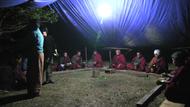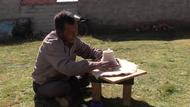Video Overview
རང་ལུགས་འབྲུག་པའི་ཁྱིམ་ལུ་ རབ་གསལ་ རྒྱལ་དཀར་ པར་གཡབ་ ཟེར་ཡོད་པའི་གྲས་ལས་ རྒྱལ་དཀར་དང་པར་གཡབ་ཀྱི་སྐོར་ལས་ དབང་འདུས་ཕོ་བྲང་ ཝ་ཅན་ལས་ བཟོ་དཔོན་རྡོ་རྗེ་གིས་བཤད་མི་ནང་ རྒྱལ་དཀར་སླབ་མི་འདི་ མིག་ཏོག་གཉིས་སྦེ་འོང་དགོཔ་དང་ པར་གཡབ་འདི་ མིག་ཏོ་གསུམ་སྦེ་འོང་དགོ་ནི་ཨིན་པས། སྤྱིར་བཏང་གིས་ ཁྱིམ་འདི་ལུ་ བཟོ་བཀོད་བྱ་ཆི་ཆི་སྦེ་མཐོང་ནི་ཨིན་པའི་གུ་ལུ་ ཤིང་ཆ་ཚུ་མ་རུལ་ནི་ཐབས་ཤེས་ཅིག་ཨིན་པས། དེ་བཟུམ་སྦེ་ རབ་གསལ་དང་རྒྱལ་དཀར་ པར་གཡབ་ཚུ་མ་བཙུགས་པ་ཅིན་ ཤིང་ཆས་ཚུ་མགྱོགས་པ་རང་རུལ་ཏེ་ ཁྱིམ་མེདཔ་འགྱོཝ་ཨིན་པས།
- Wachey
- བཟོ་དཔོན་རྡོ་རྗེ། Zopoen Dorjiཁྱིམ་འདི་ ཏེ་ང་བཅས་ མར་ཐོག་འོགམ་འདི་ལུ་འབད་རུང་རང་ ཏེ་ད་དང་པ་རང་ མར་ལས་ཡར་བཙུགས་ཏེ་གིས་སྦེ་ ཡར་ནང་ཀོ་ན་ ཨེན་ཏ་གི་ལེ་བཱལ་ན་(ཨེན་ཏ་གི་ཚད་དང་འདྲན་འདྲ་)ལྷོདཔ་ཅིགན་ སྒོ་འདི་བཙུགས་འོང་།Once the foundation of the houses reached flooring level, the door should be erected.
- བཟོ་དཔོན་རྡོ་རྗེ། Zopoen Dorjiདེ་ལས་རྒྱལ་དཀར་་་་ པ་གཡབ་འབད་བ་ཅིན་ ཏེ་ད་ སྒོ་འདི་ལས་ ཕིཊ་དོ་དེ་ཅིག་ཐུངམ་ཅིག་སྦེ་ བཟོ་ཡང་དེ་སྦེ་བཟོ།Then regarding the paryab windows, it should be raised after around 2ft from the door level.
- བཟོ་དཔོན་རྡོ་རྗེ། Zopoen Dorjiཏེ་དེ་ལས་ ཕིཊ་དོ་ ཡར་ ཏེ་ཏེ་པར་འཆམ་ད་ ལྷོདཔ་ད་ ཏེ་དེ་ལས་བཙུགས། ཡར་ལས་མར་ལྷོདཔ་ཅིག་མགུ་ཆ་འདི་ སྒོ་འདི་དང་པ་གཡབ་གྱི་མགུ་ཆ་འདི་ ཏེ་ཡར་ལས་མར་འཐོནམ་ཨིན། ལེ་བཱལ་ཅིག་ཁར་(འདྲན་འདྲ་སྦེ་)སྒྲིག་འ་ནེ་སྦེ།After ramming mud reach the level of two 2fts, (Paryab should be raised). Mud should be rammed to the level of the door.
- བཟོ་དཔོན་རྡོ་རྗེ། Zopoen Dorjiཏེ་རྒྱལ་དཀར་འབད་བ་ཅིན་ ཏེ་རྒྱལ་དཀར་གསེས་མི་འདི་ པ་གཡབ་འབད་བ་ཅིན་ མིག་ཏོ་གསུམ་དེ་ཅིག་འོང་རང་འོང་།And the ventilation window is; paryab window will have around three eyes (holes).
- བཟོ་དཔོན་རྡོ་རྗེ། Zopoen Dorjiཏེ་མིག་ཏོ་ཡང་ཨ་ཙི་སྦོམ་ཚ་ཅིག་(མཚམས་སུ་ཅིག་)འོང་། ཏེ་རྒྱལ་དཀར་དེ་མིག་ཏོ་ཡང་ཆུང་སུ་ཅིག ཏེ་ཡུདཔ་ཅིག་མིག་ཏོ་གཉིས་ལས་འགལ་གཏང་ཡང་མི་གཏང་། མིག་ཏོ་གཉིས་སྦེ་གཏང་།Paryab window will have little bigger eyes and gyalkar window the smaller and will ahve not more than two eyes (holes).
- བཟོ་དཔོན་རྡོ་རྗེ། Zopoen Dorjiཨ་ཙི་མདོར་བསྡུས་ཚ་ཅིག་(མཚམས་སུ་ཅིག་)འབད་བ་ཅིན་ ང་བཅས་ཨ་ནི་ནང་ཀོ་ན་ ཏེ་ད་སྐྱ་ཝང་ཝ་སྦེ་ མཐོང་ནི་ཅིག་དང་ རླུང་མ་རྒྱུགས་ས་ཅིག་ འ་ནི་ཅིགIn brief, (gyalkers are for) to let in the light and air.
- བཟོ་དཔོན་རྡོ་རྗེ། Zopoen Dorjiཏེ་ང་བཅས་རླུང་མ་འདི་དགོ་རང་དགོ་བ། རླུང་མ་འདི་མེད་པ་ཅིན་ ཏེ་ཤིང་ཆ་དེ་ང་བཅས་ མེདཔ་འགྱོཝ་མགྱོགས་པ། ད་འ་ནེ་སྦེ་ རླུང་མ་དེ་འ་ནེ་སྦེ་ཏེ།Air is the must for us. Without air, woods easily gets rotten.
- བཟོ་དཔོན་རྡོ་རྗེ། Zopoen Dorjiཏེ་ང་བཅས་ར་མི་སྡོད་ཏེ་ ནཱ་ལས་ཕར་ཏེ་མི་ ཏེ་ཨ་ཙི་ཅིག་ དྲོདཧིང་ཆེ་ས་འབད་བ་ཅིན་ རྒྱལ་དཀར་མེན་པ་ པ་གཡབ་རང་བཙུགས་དགོ།Incase in hot places, we have to make paryab window instead of gyalkar window.
- བཟོ་དཔོན་རྡོ་རྗེ། Zopoen Dorjiཏེ་པ་གཡབ་འབད་བ་ཅིན་ ཏེ་ད་སྒོ་དེ་བ་ཨ་ཙི་ཅིག་ ཕིཊ་དོ་དེ་ཅིག་ཐུངམ་ཅིག་སྦེ་ ཏེ་བཟོ་ཞིན་ན་ ཏེ་མར་ལས་རྩིགཔ་སྦེ་རུང་ པར་སྦེ་རུང་ཕིཊ་དོ་དེ་ཅིག་ཁར་ལྷོདཔ་ད་ ཏེ་ད་འ་ནི་པ་གཡབ་དེ་བཙུགས་དགོ།In case of (houses) with paryab, doors should be of around 2fts short and paryab window should be raised when stone or mud wall reaches to about 2fts from the down (ground level).
- བཟོ་དཔོན་རྡོ་རྗེ། Zopoen Dorjiཏེ་ཡར་ལས་ཕར་སྦྱར་ཡོད་དེ་འབད་རུང་ ཏེ་མགུ་ལས་ཕར་མགུ་ཆ་འདི་ ཏེ་ལྷོདཔ་ཅིག་ལེ་བལ་ཅིག་ཁར་(འདྲན་འདྲ་)སྒྲིག་སྦེ་ སྟེ་འ་ནེ་སྦེ་བཙུགས་འོང་ལགས།And after leveling the
 Loading ...
Loading ... 


































































































